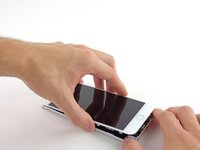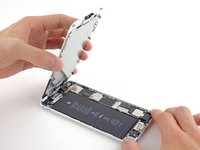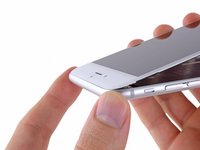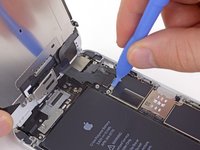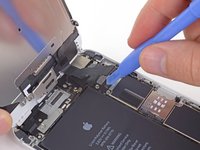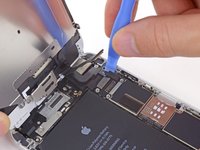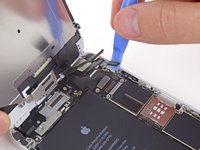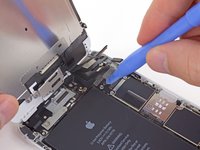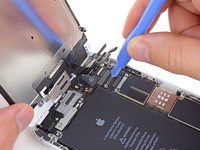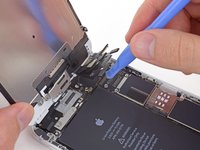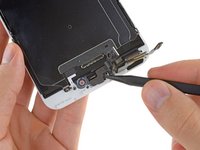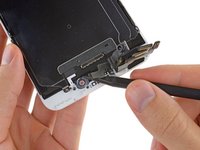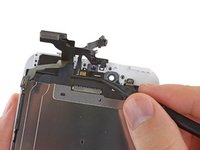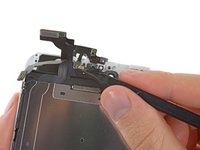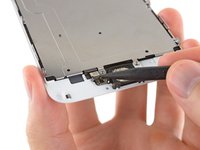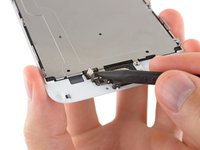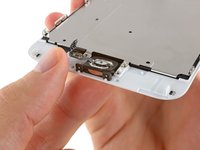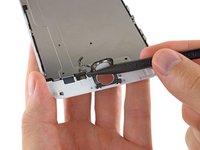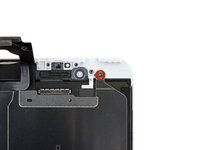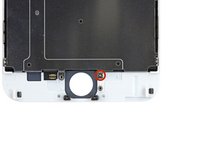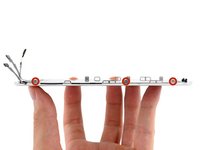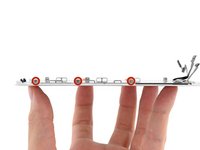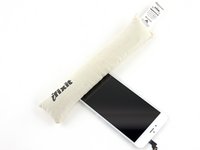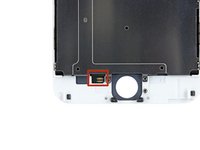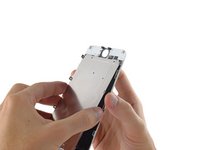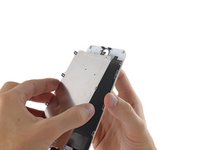crwdns2915892:0crwdne2915892:0
For an easier repair, use our fix kit and follow this shorter guide to replace your iPhone’s entire screen.
For more advanced fixers, this guide will help you replace only the iPhone’s LCD and digitizer assembly (a.k.a. the bare “front panel”). This requires you to transfer several components from your original screen to the new one before installing it—including the front-facing camera, earpiece speaker, LCD shield plate, and home button assembly.
For all screen/display repairs, it's important to transfer the original home button onto the new display in order for Touch ID (fingerprint scanning) to function.
crwdns2942213:0crwdne2942213:0
crwdns2936621:0crwdne2936621:0
-
-
Power off your iPhone before beginning disassembly.
-
Remove the two 3.6 mm P2 Pentalobe screws next to the Lightning connector.
-
-
-
If your display glass is cracked, keep further breakage contained and prevent bodily harm during your repair by taping over the glass.
-
Lay overlapping strips of clear packing tape over the iPhone's display until the whole face is covered.
-
If the broken glass makes it difficult to get a suction cup to stick in the next few steps, try folding a strong piece of tape (such as duct tape) into a handle and lifting the display with that instead.
-
-
crwdns2935267:0crwdne2935267:0Clampy - Anti-Clamp$24.95
-
Pull the blue handle backwards to unlock the Anti-Clamp's arms.
-
Slide the arms over either the left or right edge of your iPhone.
-
Position the suction cups near the bottom edge of the iPhone just above the home button—one on the front, and one on the back.
-
Squeeze the cups together to apply suction to the desired area.
-
-
-
Pull the blue handle forwards to lock the arms.
-
Turn the handle clockwise 360 degrees or until the cups start to stretch.
-
Insert an opening pick or tool under the screen when the Anti-Clamp creates a large enough gap.
-
Skip the next three steps.
-
-
-
Use a single suction cup to lift the front panel:
-
Press a suction cup onto the screen, just above the home button.
-
-
-
While holding the iPhone down with one hand, pull up on the suction cup to slightly separate the front panel assembly from the rear case.
-
Using a plastic opening tool, begin to gently pry the rear case down, away from the display assembly, while continuing to pull up with the suction cup.
-
-
-
Pull the plastic nub to release the vacuum seal on the suction cup.
-
Remove the suction cup from the display assembly.
-
-
-
Pull the home button end of the front panel assembly away from the rear case, using the top of the phone as a hinge.
-
Open the display to about a 90º angle, and lean it against something to keep it propped up while you're working on the phone.
-
Add a rubber band to keep the display securely in place while you work. This prevents undue strain on the display cables.
-
-
-
Remove the following Phillips screws from the battery connector bracket:
-
One 2.3 mm screw
-
One 3.1 mm screw
-
-
-
Remove the metal battery connector bracket from the iPhone.
-
-
-
Use a clean fingernail or the edge of an opening tool to gently pry the battery connector up from its socket on the logic board.
-
-
-
Remove the following Phillips screws securing the front panel assembly cable bracket:
-
Three 1.2 mm screws
-
One 1.5 mm screw
-
One 2.9 mm screw
-
-
-
-
Remove the front panel assembly cable bracket from the logic board.
-
-
-
While still supporting the front panel, use a fingernail or the edge of an opening tool to disconnect the front-facing camera and earpiece speaker connector.
-
-
-
Disconnect the home button cable connector.
-
-
-
Use a plastic opening tool to disconnect the display data cable connector.
-
-
-
Finally, disconnect the digitizer cable connector.
-
-
-
Remove the front panel assembly from the rear case.
-
-
-
Remove the following Phillips screws securing the upper component bracket:
-
One 1.5 mm screw
-
Two 2.3 mm screws
-
-
-
Lift and remove the earpiece bracket from the display assembly.
-
-
-
Use a the flat end of a spudger to pry up the front-facing camera and display cables, and gently push them aside.
-
-
crwdns2935267:0crwdne2935267:0Tweezers$4.99
-
Use a pair of tweezers to firmly grasp and remove the earpiece speaker from the display assembly.
-
-
-
Use the tip of a spudger to gently pry up the sensor cable assembly from its recess in the display assembly.
-
-
-
Pry the microphone portion of the front-facing camera and sensor cables from the display assembly.
-
-
-
Remove the front-facing camera and sensor cable assembly off the display assembly.
-
-
-
Remove the two 1.8 mm Phillips screws securing the home button bracket to the front panel.
-
-
-
Remove the home button bracket from the front panel assembly.
-
-
-
Use the tip of a spudger to disconnect the home button connector from its socket on the home button cable.
-
-
crwdns2935267:0crwdne2935267:0iOpener$14.99
-
Carefully wedge the tip of a spudger underneath the home button connector cable.
-
Gently move the spudger across to separate the home button connector cable from the adhesive securing it to the front panel assembly.
-
-
crwdns2935267:0crwdne2935267:0iOpener$24.99
-
Apply mild heat (with an iOpener, heat gun, or hair dryer) to soften the adhesive securing the home button gasket.
-
Using your fingertip, gently press up on the home button from the front side of the display assembly. Use firm, constant pressure to slowly separate the home button's rubber gasket from the front panel.
-
-
-
Carefully use the tip of a spudger to finish separating the home button from the front panel.
-
-
-
Lift and remove the home button assembly off the front panel assembly.
-
-
-
Remove the two 1.7 mm Phillips screws (one on top and one on bottom) securing the LCD shield plate to the display assembly.
-
-
-
Remove three 1.3 mm Phillips screws from each side of the LCD shield plate (six total).
-
-
-
Carefully lift—but do not remove—the LCD shield plate by lifting the end nearest the earpiece speaker a few millimeters from the display assembly.
-
Gently lift the other end (nearest the home button) to peel the home button cable off the display assembly.
-
Remove the LCD shield plate off the display assembly.
-
Display assembly remains.
-
To reassemble your device, follow these instructions in reverse order.
To reassemble your device, follow these instructions in reverse order.
crwdns2935221:0crwdne2935221:0
crwdns2935229:0222crwdne2935229:0
crwdns2947412:011crwdne2947412:0
I know this is a old guide but i have a question. My iphone was screen broken and i change it with a original complete iphone screen, the home button works fine but the touch id dont work. I change the home button to the one that i have in the broken screen and still the touch id dont work. What can i do to fix the touch id?
Help! The home button cable attached to the metal front panel ripped a little as I was gently using my fingers to lift it off the screen. Now the home button doesn't work. Did I ruin the phone or is it possible to get a front panel?
I recently purchased this iFixit kit for my iPhone 6 Plus replacement of my screen that was cracked. I followed the instructions above, and my phone won't turn on. There is a part in to the right of the battery, just below the screen connections, that is really hot. After I noticed it wouldn't turn on, even after plugging it in, I took it back apart, and reseated the connections again. It still doesn't work. I will not purchase this kit again.
Bought this recently and I must say that I'm a little bit disappointed:
- the screen doesn't fit as before, you can feel a rough edge - I tried 4 times to put it correctly watching many video tutorials and I had the same result so I assume it's because it's not an original screen
- the colours are not the same anymore, looks like the saturation is on a lower setting - can't see the bright colours anymore
Overall I would rate this part 6 out of 10.
Followed this guide to the letter about 1 week ago. Happy to say its very accurate and my iphone is working 100%
Most difficult and time consuming part was re-inserting the front-facing camera and sensor cable assembly (Step 25) and also removing the home button cable (step 36)





























